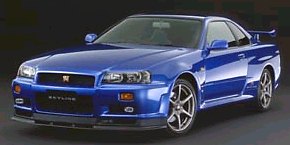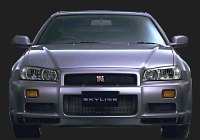 
Engineers tried to reduce weight through using lightweight material and forged metal. The bonnet and side body panels of the front are made of aluminium. The front flat bottom tray is made of glass fiber. The rear one, which has to withstand the high temperature from the exhaust pipes, is even made of carbon fiber. Forged metal parts include suspension arms (each piece 2.5kg lighter) and the 18in wheels (each 4kg lighter than the old 17in). Nissan claimed the R34 V-spec is 93kg lighter than R33 V-spec, but from my own data it is more likely to be just 40kg. If you take other new items into account, 40kg is not too bad. However, it is no doubt that the new GT-R still feels slower than Lancer GSR Evo V or Impreza STi V in terms of low speed acceleration. This is confirmed by several journalists already tested it.
Most changes are made to the aerodynamics : deeper lip spoiler, adjustable bi-plane wing, enlarged intake for intercooler, additional air inlets for front brakes and flat undertray. These improvement is likely to please the Europe market where high speed driving usually occurs. Another obvious improvement is the use of 6-speed manual box instead of 5-speed. This Getrag-made unit improves shift quality and performance. The otherwise transmission system is mainly unchanged. Items such as ATTESA E-TS PRO electronic 4-wheel-drive, Super HICAS 4-wheel-steering and active rear LSD are carried over. Brakes are still supplied by Brembo. Tyres are Bridgestone 245/40ZR18. In the cabin,
there are a
pair of new seats which have larger side supports and look very sporty.
The speedometers are surrounded by aluminium panels. Most interesting
is
the LCD screen of the satellite navigation. It also serves as the
display
for information like water temperature, oil temperature, battery
voltage,
oil level, exhaust temperature, front / rear torque split, turbo boost
pressure etc. in the form of analogue dials. |
||||||||||||||||||
| The above report was last updated on 8 Mar 99. All Rights Reserved. |
 Most
people concern whether the GT-R break the 280ps voluntary upper limit.
No, it is still 280ps, although engineers said its real ability is
330hp
without altering the state of tune. Torque, on the other hand, rises
2.5kgm
to a full 40.0kgm, still occurs at 4,400rpm. In fact, the engine is
still
the familiar RB26DETT twin-turbo 24 valves inline six, only with
enlarged
intercooler (huge air intake can be seen in the picture), revised
timing
and improved turbos. The R33 already had ceramic turbines, R34 adds
ball-bearing
to the turbine as means for minimizing friction thus improve response
and
reduce turbo lag. Furthermore, larger exhaust pipes reduce back
pressure.
Most
people concern whether the GT-R break the 280ps voluntary upper limit.
No, it is still 280ps, although engineers said its real ability is
330hp
without altering the state of tune. Torque, on the other hand, rises
2.5kgm
to a full 40.0kgm, still occurs at 4,400rpm. In fact, the engine is
still
the familiar RB26DETT twin-turbo 24 valves inline six, only with
enlarged
intercooler (huge air intake can be seen in the picture), revised
timing
and improved turbos. The R33 already had ceramic turbines, R34 adds
ball-bearing
to the turbine as means for minimizing friction thus improve response
and
reduce turbo lag. Furthermore, larger exhaust pipes reduce back
pressure.  The
tester said the GT-R does not jump start as explosively as the
lightweight
Evo VI, partly because of its weight penalty of 200kg, partly because
its
twin-turbo straight six is arranged to deliver linear output. At the
first
two gears, GT-R obviously goes slower. It starts to catch up at third,
and blast away the Mitsubishi from 4th to 5th. At 6th, which the
magazine
didn't have the chance to test, no one will doubt the GT-R will leave
the
Mitsubishi alone in smoke.
The
tester said the GT-R does not jump start as explosively as the
lightweight
Evo VI, partly because of its weight penalty of 200kg, partly because
its
twin-turbo straight six is arranged to deliver linear output. At the
first
two gears, GT-R obviously goes slower. It starts to catch up at third,
and blast away the Mitsubishi from 4th to 5th. At 6th, which the
magazine
didn't have the chance to test, no one will doubt the GT-R will leave
the
Mitsubishi alone in smoke.